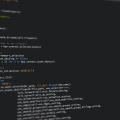A Python Requests Library is a library for developing APIs for requests. The library allows developers to create, parse, and execute HTTP requests easily. It supports both synchronous and asynchronous requests and has support for validating request parameters, header fields, and body contents.
A Python library is a set of functions and classes that help you perform everyday tasks in a Python program. These libraries may be free or paid, but they’re all open source, meaning they allow anyone to contribute to and improve the code base.
Python is a popular programming language and one of the most widely used in data science. It is an open-source programming language that allows you to write fast, concurrent applications. You can also use Python to create web applications, desktop applications, and many other types of programs. The best part about Python is that it is free and easy to use.
What is Python?
Python is a high-level, general-purpose programming language with an elegant syntax that enables programmers to concentrate more on problem-solving than on syntax issues. Keeping Python entertaining to use is one of the main objectives of Python developers. Python has gained a lot of attention in the fields of contemporary software development, infrastructure management, and particularly in data science and artificial intelligence.
What are the features of the Python Request Library?
Python is unique among programming languages in that it has many practical features. The application supports object-oriented programming in addition to procedural and dynamic memory allocation.
The following are some of the features of the Python requests library;
- Simple to Use and Understand: Python is less difficult to learn than other programming languages. Simple and largely identical to English, its syntax is easy to understand.
- Expressive Language, second: Python can accomplish difficult things with just a few lines of code.
- Interpreted Language: Python is an interpreted language, meaning that each line of code is run individually.
- Multiplatform Language: Various operating systems, including Windows, Linux, UNIX, and Macintosh, all support the Python programming language just as well.
- Free and Open Source Software: Everyone can use Python for free. It can be downloaded for free from its official website, www.python.org.
How is the Python library used? What are its advantages and disadvantages?
Python is a dynamic, high-level programming language that is interpreted and prioritizes code readability. There are several languages in use today, but Python stands out as one of the most well-liked and rapidly expanding.
Applications:
- Desktop programs with a GUI
- Applications for graphic design, image processing, games, and scientific/computational applications
- Web-based frameworks and programs
- Business and enterprise software
- Systems for Operating
Advantages:
- The presence of modules from other parties
- Vast library resources for support (NumPy for numerical calculations, Pandas for data analytics, etc.)
- A sizable, vibrant community and open source
- Flexible, Simple to Read, Learn, and Write
- Usable Data Structures
Disadvantages:
- Slow Pace
- Inefficient Memory Use
- Runtime Errors
- Mobile Computing Weakness
Examples of use cases for the Python Requests Library?
Handling redirects and captchas
HTTP redirection is already handled by contemporary libraries like requests, which follow them through (keeping a history) and return the final page. For handling redirection, Scrapy also includes a middleware. As long as we are ultimately brought to the page we seek, redirects aren’t too much of a hassle. It becomes challenging, though, if we are forwarded to a captcha.
OCR can be used to answer very basic text-based captchas (a Python module named pytesseract is available for this). With the development of sophisticated OCR techniques (based on Deep Learning, like this one), text-based captchas are becoming more difficult to deploy, making it more difficult to produce images that can outperform machines but not people.
Another option is to use one of the many services that offer APIs for captcha solving, such as Death by Captcha, Antigate, and Anti Captcha if we don’t want to deal with the overhead of doing so. The captcha is solved for you by real people who work for some of these services. However, employing proxies and IP rotation may enable you to partially evade captchas.
iframe tag management/unstructured responses
To retrieve the desired data back from iframe tags, all you need to do is make the appropriate URL request. We must first make a request for the outer page, then search for the iframe, and then send another HTTP request to the src property of the iframe. Furthermore, except for devising workarounds, there isn’t much we can do about URL patterns or unstructured HTML.
Conclusion
The modules in this library have been written using the Python programming language. This means that they can be used by any other Python project without any issues.
A Request Library is a python module that provides you with an interface to the HTTP protocol. This module will allow you to make HTTP requests to any web server using the Python programming language.
You can think of a Request Library as a library for making HTTP requests, but without all the work of implementing the library yourself.







